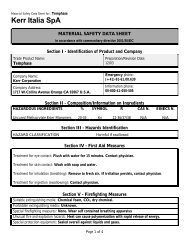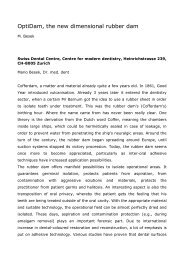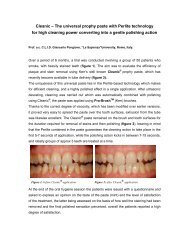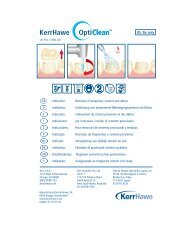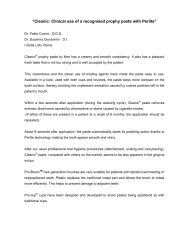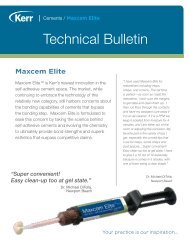Restorative Procedure - Kerr Hawe
Restorative Procedure - Kerr Hawe
Restorative Procedure - Kerr Hawe
Create successful ePaper yourself
Turn your PDF publications into a flip-book with our unique Google optimized e-Paper software.
for resistance, biocompatibility, and of course<br />
aesthetic appearance. Composite resins have now<br />
been in use for over three decades and in recent<br />
years have become a solution that is adopted<br />
more often, because of their excellent aesthetics<br />
and their ever better mechanical properties (3).<br />
The term composite refers to a combination of at<br />
least two chemically diverse materials, with a distinct<br />
interface to separate the two components. Superior<br />
properties are exhibited when in combination,<br />
opposed to when used separately.<br />
When formulating a composite resin, we identify<br />
three different components:<br />
• Organic matrix;<br />
• Inorganic filler;<br />
• Binding agent.<br />
The organic matrix of the most modern composite<br />
resins consists mainly of the monomer developed<br />
by Bowen in 1957, through a reaction between<br />
one molecule of bisphenol A and two molecules<br />
of glycidyl methacrylate (GMA), yields a viscous<br />
monomer of high molecular weight which is called<br />
BISGMA. In the formulation of the matrix of<br />
composite resins we then find other monomers of<br />
lower molecular weight in lower percentages such<br />
as TEDGMA (triethylene glycol dimethacrylate, the<br />
most used), UEDMA (diurethane dimethacrylate,<br />
sometimes used as the sole component of the<br />
matrix), MMA (methyl methacrylate) and others of<br />
less importance and little used.<br />
The second component of a composite resin is<br />
the inorganic filler, which is added to the matrix<br />
to increase its resistance characteristics, which<br />
are otherwise insufficient, such as hardness,<br />
resistance to compression, resistance to wear<br />
and impermeable.<br />
The fillers can be classified on the basis of their<br />
chemical nature into fillers based on silicon dioxide<br />
or colloidal silica, quartz, vitreous materials, other<br />
metals or zirconium.<br />
On the other hand, Bayne in 1994 suggested the<br />
following subdivision based on the diameter of<br />
the particles:<br />
• mega fillers (from 2 to 0.5 mm)<br />
• macro fillers (from 100 to 10 µm)<br />
• medium fillers (from 10 to 1 µm)<br />
• mini fillers (from 1 to 0.1 µm)<br />
• micro fillers (from 0.1 to 0.01 µm)<br />
• nano fillers (from 0.01 to 0.005 µm)<br />
Based on production techniques, conventional or<br />
traditional fillers are produced by trituration of the<br />
inorganic substances listed above, obtaining a<br />
macro filler with particles of irregular shape and<br />
size, which require little monomer to become wet,<br />
therefore conferring less viscosity, but they make<br />
the restoration difficult to finish and polish and<br />
also favour the formation of micro fractures.<br />
Fillers obtained by precipitation of pyrogenic silica<br />
at high temperatures, introduced successively,<br />
18<br />
Your practice is our inspiration.




